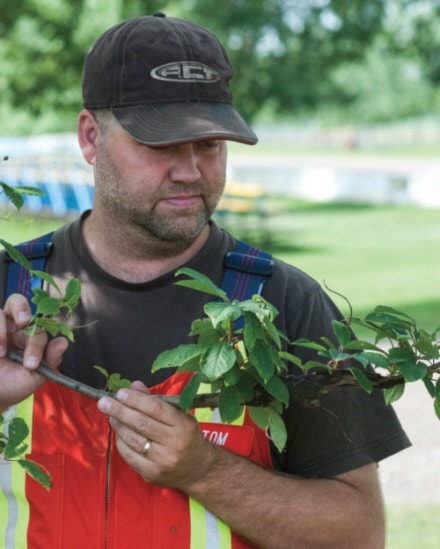Lacombe is facing an epidemic of sorts.
Black Knot disease, a parasitic fungus that attacks trees of the cherry family, is running rampant in Lacombe.
Tom Lee, arborist for Lacombe Parks, said that Black Knot thrives in hot humid conditions such as Lacombe has been experiencing lately and while eliminating the disease entirely is unrealistic, it is something that needs to be controlled.
“It’s like any other weed or pest,” said Lee. “Control it where you find it. If you don’t it only gets worse.”
Black Knot is highly contagious and will deform trees that it infects. Contact from birds and insects as well as wind can carry the Black Knot fungus spores from tree to tree, said Lee.
Chokecherries, pincherries, hackberry (May Day trees) and other members of the cherry family of trees are most at risk for Black Knot, said Lee. He added that he has heard of other plants, like decorative plums, being infected as well but has not seen any such cases within Lacombe.
While Black Knot disease is highly contagious and can be very damaging to the trees it infects, it is also easy to spot and luckily has a simple cure.
Black Knot manifests on trees in swells that turn to black burls and are easily identified. To treat an infected tree, simply prune the infected branches back six to eight inches from the burl or to the nearest junction point.
It is also a good idea to sterilize pruning tools and hands while treating trees as well, said Lee, because touching infected parts of the tree and then touching another limb can also spread the fungus.
Any alcohol-based solution can work as sterilizer, said Lee. He also advised against pruning infected trees in wet or rainy weather, as the spores can be transferred through water as well.
As Black Knot spores are still active on branches even after they have been removed from a tree, Lee said the best way to get rid of infected branches is to burn them after pruning them from the tree. Lacombians also have the option of taking them to the Wolf Creek Recycling Depot where they will be properly disposed of or taking them to Prentiss Landfill where they will be burned or buried.
A tree with a thick canopy can hold humidity and heat, which encourages the spread of Black Knot. So, regularly pruning trees to keep thinner canopies also helps control the fungus, said Lee.
He added that pruning can even be done in winter, whether the tree is infected or not, as both the trees and fungus are dormant at that time.
Lee said it is difficult to know just how many trees have been affected by the fungus, but he would estimate about 75% of Lacombe’s (cherry family) trees are infected.
In Michener Park for example, every tree that is a member of the cherry family has been infected with the disease.
City of Lacombe crews have even had to remove some trees entirely because the disease had spread throughout the entire tree.
